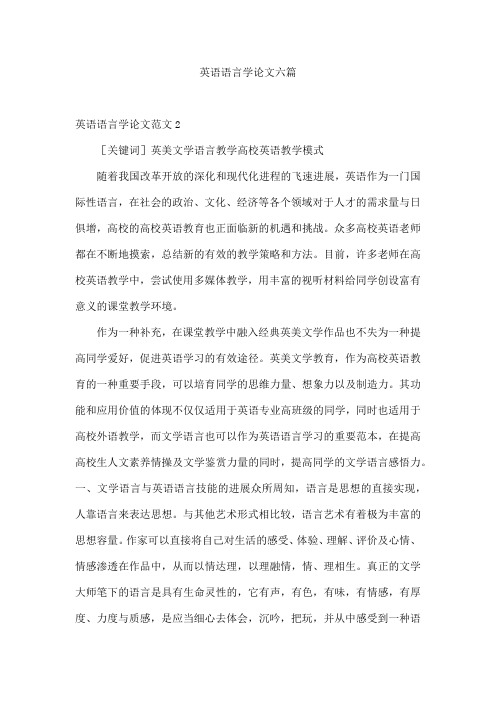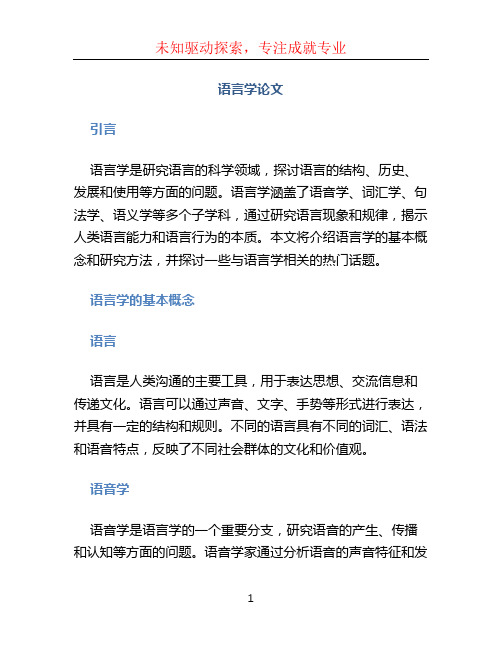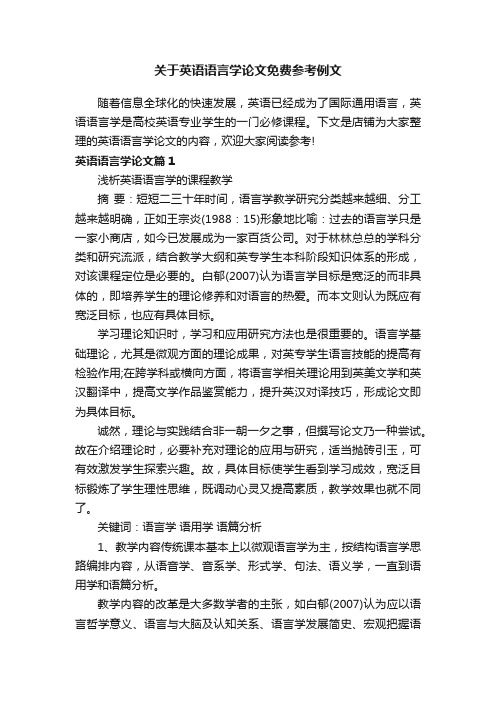语言学论文
英语语言学论文(优秀9篇)

英语语言学论文(优秀9篇)《浅析美国英语与英国英语的区别及应用》摘要:标准现代英式英语和美式英语,虽然两者互相理解没有很多实质性的差异,但对两者的各方面进行一个大概的比较,还是有很多细微的差别的。
关键词:美国英语;英国英语;分析对比;区别及应用在全球一体化的背景下,英语已成为世界通用语言,在社会生活、交往或交流中都扮演着重要角色。
近年,美式英语风靡全球,尽管美式英语和英式英语都是英语,但是区别甚多。
相对来说美式英语便捷实用,英式英语较为复杂。
英式英语保守、严谨,美国人说英语则是另一种姿态,崇尚可见即可读。
1.两种语言在历史演变、地域文化、社会地位层面的区别。
英语是全世界几千种语言的其中一种,也是印欧语系一百多种语言之一、英国英语距今已有1500的历史了。
而美国英语是在英国英语的基础上发展而来的。
英国和美国在政治、经济、文化等方面的不断发展,造就了它们各自不同的语言特征。
美式英语起源于18世纪70年代,美国的独立战争爆发时,战乱的特殊原因导致绝大多数美国人来自欧洲移民,尤其以英格兰人为主,大多讲英国英语。
近几十年来,由于美国的贸易、军事、科技、国际地位等方面远远超过英国,再加上美国电影风靡全球,促使美国本土的俚语很多已经渗透到了口语之中。
很多因素导致美式英语成为强势语言。
2.发音方面存在的不同。
英语和美语的发音最具代表性的区别是对er的发音的不同。
英语中,短音的er是的浑元音,但长音的er是个拉长了的浑元音,听起来是一个介于“俄”和“啊”的声音。
而美语中,er听起来怎么都是个“儿”音。
ar:除了轻读短音(如singular)和者后连元音(如clarity),英语的ar全部清一色的长音[a:],而美语中,是“阿尔”。
英语和美语的辅音基本是一致的,但在使用习惯上也有些差别。
如词组clear animosity,英语会读成clear,animosity,而美语会读成clear—ranimosity。
另一个比较明显的区别是d和t。
语言学论文题目

语言学论文题目第一部分:引言语言学是一门研究人类语言的科学,它探讨了语言的起源、结构、演化和功能等方面的问题。
语言学的研究不仅仅包括了对于各种语言的描述与分析,还包括了对于语言习得、语言使用和语言交流等方面的研究。
本论文将深入探讨语言学的相关话题,以期对语言学的理论和实践做出一定的贡献。
第二部分:语言与思维语言与思维是语言学研究中的一个重要领域。
它探讨了语言与人类思维之间的关系。
一些语言学家认为,语言是思维的一种表达形式,它反映了人类的认知和思维方式。
而另一些语言学家则认为,语言反过来也影响了人们的思维方式。
本论文将详细探讨语言与思维之间的相互关系,并通过具体的案例展示语言如何塑造了人类思维。
第三部分:语言演化与社会变迁语言的演化是一个长期的过程,它随着社会的变迁而不断变化。
语言学家通过对不同时期和地区的语言进行研究,了解语言的演化规律和变异现象。
本论文将对语言演化与社会变迁进行梳理,并将重点讨论语言变异的原因和影响因素。
通过对语言的演化和社会变迁的研究,我们可以更好地理解语言的起源和发展,以及语言与社会变迁之间的相互作用关系。
第四部分:语言习得与语言教育语言习得是指人们在儿童时期通过与他人的交流逐渐掌握一门语言的过程。
语言习得是语言学研究中的一个重要领域,它涉及到语言的认知、语音、语法和语用等方面的问题。
语言教育则是指人们通过教学和学习的方式来习得一门语言。
在本论文中,我们将对语言习得和语言教育进行综合分析,探讨不同因素对语言习得和语言教育的影响,并提出相应的改进措施。
第五部分:语言与文化语言与文化密切相关,它们互相影响和塑造着彼此。
不同的语言体现了不同的文化特点和社会习俗,而文化则通过语言的传承和交流方式得以传递和演化。
本论文将探讨语言与文化之间的关系,并以案例分析的方式展示语言如何影响文化的发展和演变。
通过对语言与文化的研究,我们可以更好地理解不同文化之间的差异和联系,促进跨文化交流和理解的发展。
英语语言学论文六篇

英语语言学论文六篇英语语言学论文范文2[关键词]英美文学语言教学高校英语教学模式随着我国改革开放的深化和现代化进程的飞速进展,英语作为一门国际性语言,在社会的政治、文化、经济等各个领域对于人才的需求量与日俱增,高校的高校英语教育也正面临新的机遇和挑战。
众多高校英语老师都在不断地摸索,总结新的有效的教学策略和方法。
目前,许多老师在高校英语教学中,尝试使用多媒体教学,用丰富的视听材料给同学创设富有意义的课堂教学环境。
作为一种补充,在课堂教学中融入经典英美文学作品也不失为一种提高同学爱好,促进英语学习的有效途径。
英美文学教育,作为高校英语教育的一种重要手段,可以培育同学的思维力量、想象力以及制造力。
其功能和应用价值的体现不仅仅适用于英语专业高班级的同学,同时也适用于高校外语教学,而文学语言也可以作为英语语言学习的重要范本,在提高高校生人文素养情操及文学鉴赏力量的同时,提高同学的文学语言感悟力。
一、文学语言与英语语言技能的进展众所周知,语言是思想的直接实现,人靠语言来表达思想。
与其他艺术形式相比较,语言艺术有着极为丰富的思想容量。
作家可以直接将自己对生活的感受、体验、理解、评价及心情、情感渗透在作品中,从而以情达理,以理融情,情、理相生。
真正的文学大师笔下的语言是具有生命灵性的,它有声,有色,有味,有情感,有厚度、力度与质感,是应当细心去体会,沉吟,把玩,并从中感受到一种语言的趣味性。
因此语言的背后是人的心灵世界。
对文学语言美的敏感与驾驭力量,是提高人的精神境界,使人变得更加美妙的不行或缺的方面。
文学阅读的魅力与意义也就在于此。
目前的高校英语教学,仍旧停留在传统的单纯课文教学,语言点讲解等层面上,课本内容相对陈旧,老师的教学手段也并无创新之处。
其弊端是忽视英语的基本功能即表达功能,也忽视了同学在教学活动中的主体作用,另外还忽视了对同学英语学习爱好的培育,将生硬的课本内容强行“灌输”;至同学脑海中,使整个课堂教学环节缺乏生气,长此以往,高校英语教学将陷入僵局。
从意义角度语言学[论文]
![从意义角度语言学[论文]](https://img.taocdn.com/s3/m/69b2610e90c69ec3d5bb751e.png)
从意义角度浅谈语言学摘要:语言学包含六大分支,但各分支并非界限分明,完全独立。
它们之间有一条贯穿始终的线----意义。
本文从意义的角度宏观地综述语言学中的各个分支及各个分支之间的统一性和关联性,从而对语言学的宏观全貌以及其内在联系有更清晰的认识。
关键词:语言学意义语音学句法学词汇学语义学语用学语言学是对语言进行全面,科学研究的学科。
从研究范围看,分为内部语言学(又称微观语言学)和外部语言学(又称宏观语言学)。
语言学(本文中指内部语言学)主要研究语言的内部结构。
由于研究角度不同,语言学包含语音学,音系学,句法学,语义学和语用学六大分支。
它们彼此之间并非界限分明,绝对独立,而是相互交叠,相互联系,相互依赖。
如果生硬地将语言学切成几块互不关联的分支来研究的话,我们也难以真正地看清语言学的全貌更不能真正地解释和发掘语言的奥秘和魅力。
因而,我们绝不能忽视语言学各个分支之间的关联即接口(interface).例如语义学与语用学都研究语言的意义。
但前者研究的研究对象是语言本身表达的意义,而后者研究的是说话者在某一语境中的意向性意义。
两者紧密联系,但又互相补充,区分的关键因素在于语境(context)和意向(intention). 例如语义学与语用学都研究语言的意义。
但前者研究的研究对象是语言本身表达的意义,而后者研究的是说话者在某一语境中的意向性意义。
两者紧密联系,但又互相补充,区分的关键因素在于语境(context)和意向(intention).因此从宏观总体的角度来看语言学也显得尤为重要。
在逐渐认识并不断探索语言学的过程中,作者惊奇地发现有一条无形抽象的线贯穿整个语言学各个分支,分别与各分支结合交织并最终将语言学各个分支紧密地融合在一起,形成一个统一的整体。
这条线就是意义(meaning)。
这里所说的“意义”是广义上的,涵义非常广,涵盖三大方面,一是语言的意义,即狭义的语义学。
二是哲学上的意义,研究意义与指称,内涵,外延,实在等的关系以及真实性的问题。
语言学论文

语言学论文引言语言学是一门研究人类语言系统及其规律的学科。
它涉及了语音学、语法学、语义学、语用学等各个方面的研究。
本论文旨在探讨语言学的基本概念、发展历程以及其在语言教学中的应用。
1. 语言学的基本概念1.1 语言学的定义语言学是指对语言进行研究的学科,它不仅包括对语言的结构、语音和语法等方面的研究,还涉及了语言发展、语言变异以及语言间的关系等问题。
1.2 语言学的分类根据研究的内容和方法,语言学可以分为多个子学科。
其中,语音学研究语音的产生、传播和接收过程;语法学研究句子的结构和构成要素之间的关系;语义学研究词义和句子意义的生成和理解规律;语用学研究语言在社交交际中的使用。
2. 语言学的发展历程语言学的研究可以追溯到古代,但作为一门独立的学科,它的发展起源于19世纪。
20世纪以来,语言学在理论和方法上有了长足的进步,出现了多个流派和学派。
2.1 结构主义语言学结构主义语言学是20世纪初期的一种主导流派。
它通过分析语言的内部结构和音素、词汇、句法等元素之间的关系来揭示语言的规律。
2.2 生成语法学生成语法学强调语言的生成过程,认为句子是通过一定的规则和原则从基本句法元素生成的。
这种方法启发了计算机科学家发展自然语言处理的技术。
2.3 语用学的兴起语用学的兴起使得语言研究不再局限于语言的结构,而是将语言与社会交际和语境结合起来考虑。
语用学的成果为实际语言应用领域带来了重要的启示。
3. 语言学在语言教学中的应用语言学的研究成果在语言教学中起到了重要的指导作用。
语言教学注重培养学习者的语言能力和交际能力,而语言学为教师提供了有关语法、词汇、语音等方面的理论知识和实践经验。
3.1 语音教学语言学对语音的研究使得语音教学更加科学和系统化。
教师可以根据语音学的知识教导学生正确的语音发音和口腔运动。
3.2 语法教学语法是语言的骨架,语言学的研究为语法教学提供了理论基础。
教师可以借助语法学的知识帮助学生掌握词类、句法结构、句子联接等语法知识。
语言学论文

语言学论文引言语言学是研究语言的科学领域,探讨语言的结构、历史、发展和使用等方面的问题。
语言学涵盖了语音学、词汇学、句法学、语义学等多个子学科,通过研究语言现象和规律,揭示人类语言能力和语言行为的本质。
本文将介绍语言学的基本概念和研究方法,并探讨一些与语言学相关的热门话题。
语言学的基本概念语言语言是人类沟通的主要工具,用于表达思想、交流信息和传递文化。
语言可以通过声音、文字、手势等形式进行表达,并具有一定的结构和规则。
不同的语言具有不同的词汇、语法和语音特点,反映了不同社会群体的文化和价值观。
语音学语音学是语言学的一个重要分支,研究语音的产生、传播和认知等方面的问题。
语音学家通过分析语音的声音特征和发音方式,揭示语音的音位系统和音韵规律。
语音学对于理解语言的音素、音韵和音系等基本要素具有重要意义。
词汇学词汇学是研究词汇的学科,包括词汇的形态、词义、构词法和词汇变化等方面的内容。
词汇是语言的基本单位,通过词汇的组合和变化,人们可以构建不同的表达方式和意义。
词汇学的研究对于理解语言的语义结构和表达方式具有重要参考价值。
句法学句法学是研究句子的结构和语法规则的学科,包括句子成分、句子类型和句法关系等方面的内容。
句法学家通过分析句子的组织和成分之间的关系,揭示语言的语法结构和句法规则。
句法学的研究对于理解语言的句法结构和语法变化具有重要意义。
语义学语义学是研究语言的意义和人类思维的学科,涉及词义、句义和篇章意义等方面的内容。
语义学家通过分析词汇和句子的意义,探讨语言表达的逻辑关系和语义关联。
语义学对于理解语言的意义和语篇逻辑具有重要参考价值。
语言学的研究方法语言学的研究方法主要包括田野调查、统计分析和实验研究等。
以下将简要介绍这些研究方法:田野调查田野调查是语言学研究中常用的一种方法,通过对自然环境和语言使用情况的观察和记录,获取真实的语言数据。
研究人员可能会采访当地的居民,记录他们的口头语言和方言等。
汉语语言学论文范文

汉语语言学论文范文汉语言文学在我国的灿烂文化中起着支撑的作用。
尽管社会的诸多领域并不是建立在汉语言文学的基础上,然而,其需要思维能力、判断能力、沟通协调能力,都和汉语言文学息息相关。
下面是店铺为大家整理的汉语语言学论文,供大家参考。
汉语语言学论文范文一:高职选修课汉语言文学论文一、高职汉语言文学选修课建设探索根据前文所述,依照汉语言文学的课程要求,需要教师在教学过程当中提高个人的专业素养,知识面更加全面。
所以对培养汉语言文学教师的课程选材、内容等要求更高。
(一)“三维”课程目标须质性提升不同的高等院校的人才培养方式、目标都有区别,不同的体系会随着行业的发展而不断发展。
所以汉语言文学的教学也应当按照时代的进步而不断地革新。
所以高校汉语言文学的教学目标也应当随之改变。
比如,为了达到现阶段对汉语言文学教师的文学功底等要求,教学专业需要将“三维”课程目标进行全方位的提升。
新课改的“三维目标”体现了素质教育的要求,体现了全新发展的新时代要求,“三维目标”不能有所偏颇;另外,要落实汉语言新课程的“三维目标”,全面提高学生的汉语言素养,需要在更高层次上具有“三维目标”素养的汉语言教师。
首先,应当努力提升教师的文学素质与教学能力,从而达到“学术性”与“师范性”的有机统一。
在其课程中,中学的汉语言阅读量相对较大,所以需要教师带领学生进行感悟,从而提升学生的文学鉴赏能力。
可见汉语言文学教育的基本目标在于提升学生的阅读水平,清晰学生文学的思维,从而在知识面与自学能力方面上一个台阶。
这样才能较为全面地达到“三维”课程目标。
然而,“三维目标”应体现在汉语言文学教育专业课程的各科教学中,只是不同学科中“三维目标”所体现的比例和层次会有所不同。
总的来说,目标是一个方向性指导,在整个教学活动中应该全面地把握学生的专业知识培养,增强学生基本素质,确立正确的价值观。
(二)课程结构需匹配汉语言教师专业素养汉语言的新课程在内容与架构等方面第一次提出了综合性学习内容和模块课程,甚至在高中有相关的选修课。
关于英语语言学论文免费参考例文

关于英语语言学论文免费参考例文随着信息全球化的快速发展,英语已经成为了国际通用语言,英语语言学是高校英语专业学生的一门必修课程。
下文是店铺为大家整理的英语语言学论文的内容,欢迎大家阅读参考!英语语言学论文篇1浅析英语语言学的课程教学摘要:短短二三十年时间,语言学教学研究分类越来越细、分工越来越明确,正如王宗炎(1988:15)形象地比喻:过去的语言学只是一家小商店,如今已发展成为一家百货公司。
对于林林总总的学科分类和研究流派,结合教学大纲和英专学生本科阶段知识体系的形成,对该课程定位是必要的。
白郁(2007)认为语言学目标是宽泛的而非具体的,即培养学生的理论修养和对语言的热爱。
而本文则认为既应有宽泛目标,也应有具体目标。
学习理论知识时,学习和应用研究方法也是很重要的。
语言学基础理论,尤其是微观方面的理论成果,对英专学生语言技能的提高有检验作用;在跨学科或横向方面,将语言学相关理论用到英美文学和英汉翻译中,提高文学作品鉴赏能力,提升英汉对译技巧,形成论文即为具体目标。
诚然,理论与实践结合非一朝一夕之事,但撰写论文乃一种尝试。
故在介绍理论时,必要补充对理论的应用与研究,适当抛砖引玉,可有效激发学生探索兴趣。
故,具体目标使学生看到学习成效,宽泛目标锻炼了学生理性思维,既调动心灵又提高素质,教学效果也就不同了。
关键词:语言学语用学语篇分析1、教学内容传统课本基本上以微观语言学为主,按结构语言学思路编排内容,从语音学、音系学、形式学、句法、语义学,一直到语用学和语篇分析。
教学内容的改革是大多数学者的主张,如白郁(2007)认为应以语言哲学意义、语言与大脑及认知关系、语言学发展简史、宏观把握语言学真正意义等四方面为重。
还有学者认为增加课外阅读材料以改进教学内容,如王扬(2004)和吴格奇(2005)主张选用有助于学生理解基本理论、概念的材料、辅之以拓宽视野的补充材料。
还有以宏观还是微观语言学内容作为教学重点的争论:“微观”派认为语言内部分支是语言学的基础内容,课时分配比重要大;“宏观”派认为基础部分简单,学生可自学,重点应是宏观介绍;“中间”派是既注重基础又考虑涉猎面。
- 1、下载文档前请自行甄别文档内容的完整性,平台不提供额外的编辑、内容补充、找答案等附加服务。
- 2、"仅部分预览"的文档,不可在线预览部分如存在完整性等问题,可反馈申请退款(可完整预览的文档不适用该条件!)。
- 3、如文档侵犯您的权益,请联系客服反馈,我们会尽快为您处理(人工客服工作时间:9:00-18:30)。
2013-2014学年第二学期英语语言学课程考查内容总结Language in Use姓名:王亚兰班级:英语114班学号:20111114417This chapter introduces the Pragmatic–the use of language, which is the main branch of linguistics. It differs from the Semantics, it depends more on the context. In this chapter, we will cover the knowledge about pragmatics, and we mainly study three theories when we use language in real life: Speech Act Theory, Conversational Implicature and Relevance Theory of Post-Gricean Theories. Through the study of the word meaning we say in different contexts, we can acquire more about communicative rules and the accurate use of language.The Pragmatic is the study of the intended meaning of a speaker (the meaning in context use), but the Semantics is the study of the literal meaning of a sentence (the meaning in abstractness). In the certain context, the Semantics is concerned with the sentence meaning, will usually answers "what does X mean?"In that it studies meaning not in isolation but in context. However, the Pragmatics is concerned the utterance meaning, which answers "what do you mean by X?" Pragmatics manifests the utterance meaning, which is actually based on sentence meaning and it's the realization of sentence meaning in a context of situation. Therefore, we can know that the Pragmatics is the language in use, the meaning in context about the speaker's meaning, utterance meaning, and contextual meaning.Many linguists have studied the use of language, so there are many theories in the study of language in use. The first major theory originated with the book "How to Do Things with Words" written by John Langshaw Austin in the 1950's. According to Speech Act Theory, we are performing actions when we are speaking. So he classified the sentences with two types: Performatives and Constatives. The performative is a sentence like "I name the ship the Queen Elizabeth", which does not describe things and cannot be true or false. Its sentences used to perform such functions. We can say the uttering of a performative sentence is a part of the doing of an action. In contrast, the constatives a sentence like "I pour some liquid into the cube" is a description of what the speaker is doing at the time of speaking. It is a constative sentence. We can distinguish them in two rules: felicity conditions and grammatical and lexical criteria. Afterwards, a simplified version of the felicity conditions is suggested by Austin, but soon he realized that these conditions only applied to some cases.A speaker might be performing three acts simultaneously when speaking: locutionary act, illocutionary act, and perlocutionary act. A locutionary act is that when we speak we move our vocal organs and produce a number of sounds, organized in a certain way and with a certain meaning. It is the uttering of a sentence with determinate sense and reference. An illocutionary is that when we speak we move our vocal organs and produces a number of sounds, organized in a certain way and with a certain meaning; it is the making of a statement, order, promise etc. in uttering a sentence by virtue of the conventional force associated with it. A perlocutionary act is the act performed by or resulting from saying something; it is the consequence of, or the change brought about by utterance; it is the act performed by saying something. It is bringing about of effects on the audience by means of uttering the sentence, such as efforts being special to the circumstance. In fact, Austin focused on the illocutionary act, so speech act theory is a theory of illocutionary.The second major theory is the theory of conversational implicature, proposed by Herbert Paul Grice. He argues that we seem to follow some principle which is known as the Cooperative Principle. It refers to the "co-operation" between speakers in using the maxims during the conversation. To specify CP further, Grice introduced four categories of maxims: Quantity–speak as informative as is required instead of speak more informative, Quality–the speaker should speak the truth and avoid the false and lack adequate evidence; Relation–be relevant; Manner–the speaker should speak brief and orderly words, avoid the obscure and ambiguous expression.However, in real context, the CP and maxims will not be followed all the time. People do violate them and tell lies. Conversative Implicature can only be worked out on the basis of the CP. Lies do not have implicature proper. They will violate the maxims of quantity, for example, when an asked B where did he buy his coat, B answered: “In a department store, it is quite far from here “;B's part is more than required and violate the maxims of quantity. They will also disobey the maxim of quality, such as the sentence "he is made of steel", because it is a false statement. When transferring an embarrass situation, we will usually break the maxim of relation. Moreover, when the kids want to get something to eat, the mother answered: “I vetoI-C-E-C-R-E-A-M" to remark an obscurity, it violates the maxims of manner.Grice also mentioned brief some characteristics of conversational implicature: Calculabitity: It shows the conversational implicature must need the necessary data, such as according to the conventional meaning of words used or the linguistic and situational contexts. Cancellablity: The implicature can be cancelled by the change of any of these factors. Non-detachability: An implicature will not be detached, separated from the utterance as a whole, even though the specific words may be changed. Non-conversationality: Implicature is indeterminate and it varies with the context.After Grice, the theory of coversational implicature developed furtherly. The famous theory was the relevance theory proposed by Dan Sperber and Deidre Wilson. They all think all Gricean maxims, including the CP itself, should be reduced to a single principle of relevance. It is defined as:Every act of ostentive communication communicates the presumption of its own optimal relevance.The use of language is a complicated process, which is concerned with the psychology, cultural background and the using habit of the language etc. between two speakers. Through the study of this chapter, we can understand the relevant conception and acquire relevant definition. It refers to three major theory: in the speech act theory, it emphases two conceptions: the definition and discrimination between performative and constative, and the speech act theory ,which defined the concrete meaning in actual context of the locutionary act, illocutionary act and perlocutionary act proposed by Austin. It also focuses on the second theory: Conversational implicature, including the CP theory and the characteristics of conversational implicature. Besides, it contains the Post-Gricean developments: the Relevance Theory. We will have an acquisition of how speakers to use a sentences to effect successfully communication.。
